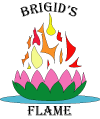WICCA - MODERN WITCHCRAFT
Wicca is a form of modern witchcraft tracing its lineage to Gerald B. Gardner, who first wrote about witchcraft in the 1950s. Although Gardner claimed that the coven he found and participated in from the New Forest area of England traced its roots back to pre-historic times, this has never been proven (nor disproven). Thus, it is reasonable to say that Wicca is modern witchcraft and is only traced as far back as Gardner's time.
The term "Wicca" in reference to a form of witchcraft was not used in Gardner's time - witchcraft was witchcraft then. "Wicca" is very likely a mis-spelling of "Wica" which Gardner did use in his book, Witchcraft Today. In that book, Gardner wrote "What are they (witches) then? They are the people who call themselves the Wica, the "wise people", who practise the age-old rites and who have, along with much superstition and herbal knowledge, preserved an occult teaching and working processes which they themselves think to be magic or witchcraft." (page 102) Be that as it may, Gardner's witchcraft has evolved over time and eventually the name, Wicca, was used to refer to the form of witchcraft he learned and later taught to his Priestesses. Wicca and witchcraft are also often referred to as "the Craft".Wicca continued to evolve and grow over time. Although its origins started in England, this form of witchcraft made its way to the United States, Canada, and Australia. People started to learn about Wicca and then started their own covens modifying some of the practices and some of the beliefs to suit their specific needs. Because of this evolution in the Craft, those who were taught directly by Gardner came to be called Gardnerians. As well, there was Alexandrian Wicca, which was formed by Alex and Maxine Sanders. Alex Sanders formed his tradition claiming to be an initiated witch through family and later through Gardner. It is still debated (hotly by both Alexandrians and Gardnerians) whether or not Alex Sanders actually had a copy of the Gardnerian Book of Shadows on which to base his rituals. Currently, there are a plethora of Wiccan traditions of which one may choose to practice and join. Many are private traditions and only teach and initiate those they feel are compatible with the tradition. There are grass-roots traditions formed based off of books by Wiccan authors such as Scott Cunningham or Silver RavenWolf - though these traditions cannot necessarily claim lineage back to Gardner's time, and their practices may or may not be based on what Gardner taught. Actually, more and more of the grass-roots traditions seem to be popping up in recent years. (Is this because of Wicca's growing popularity as a religion? Are these real witchcraft traditions that are coming out of the "broom" closet because of increasing tolerance for witchcraft? Or are these completely made-up traditions based on reading a few books on witchcraft?) Odyssean Wicca, which I studied, is a tradition that traces to Gardner as well as Sanders. It was formed around the 1970s. The original coven consisted of initiated Wiccans from different traditions at that time. Over time, it was decided that they name their tradition, and Odyssean was chosen based on the Odyssey in Greek mythology.
Wicca is an initiatory, oath-bound, mystery religion. The form of witchcraft Gardner found and was taught required initiation. It required making an oath, and through the religion's practices and teachings one learned "the mysteries". In Wicca, rituals are performed as a form of reverence for nature and deity. There are Priests and Priestesses in Wicca. Most traditions of Wicca have three levels or degrees of priesthood - first, second, and third. Priesthood of second and third degree are called High Priest or High Priestess.
Wicca, like paganism and witchcraft, reveres nature and emphasizes connection with the natural world through celebrating the seasonal festivals, called sabbats, and through celebrating the moon cycle. Unlike paganism and witchcraft though, Wicca relies heavily on ceremonial magic, which is (as the phrase suggests) heavily dependant on ceremony.
Wicca today is still growing and evolving. The most concise and accurate definition of Wicca so far is provided by the Wiccan Church of Canada on its FAQ page.
If you wish to learn more about Wicca (in particular, Odyssean Wicca), please visit the Wiccan Church of Canada website. If you would like to learn more about witchcraft simply browse this website and my blog as I will be writing about witchcraft on occasion. I will be providing a reading list later, but for now I'd recommend reading Witchcraft for Tomorrow, The Rebirth of Witchcraft, and Natural Magic by Doreen Valiente; Witchcraft for Today by Gerald B. Gardner; Drawing Down the Moon by Margot Adler; and What Witches Do by Stewart Farrar. If you're really brave and love to read a lot, read Triumph of the Moon by Ronald Hutton and A Witches Bible by Janet and Stewart Farrar. The Farrars' book was originally published as two separate books called Eight Sabbats for Witches and The Witches' Way. You may want to read Wicca: a Guide for the Solitary Practitioner by Scott Cunningham for some practical information.
A Witch's Curriculum of Study (Here you will find a list of subjects that I studied during my years at the WCC.)
Disclaimer: All opinions expressed on this site regarding Wicca, witchcraft, and paganism are strictly those of myself, unless otherwise indicated, and do NOT represent ALL Wiccans, witches, or pagans.
Copyright C.J. Chow December 2006, revised November 2007
